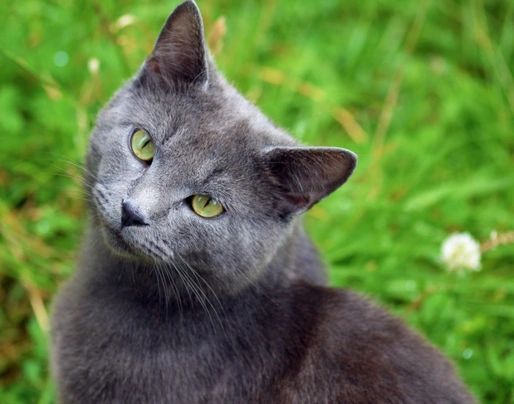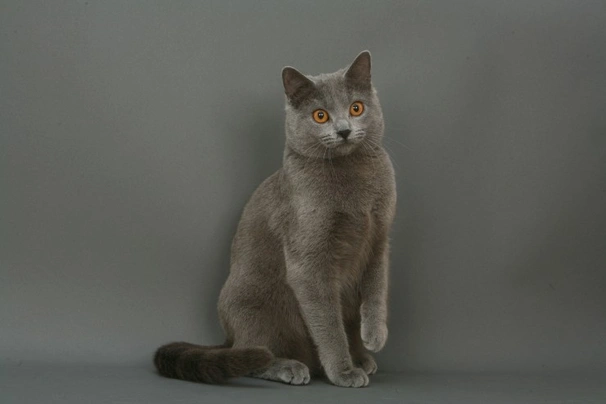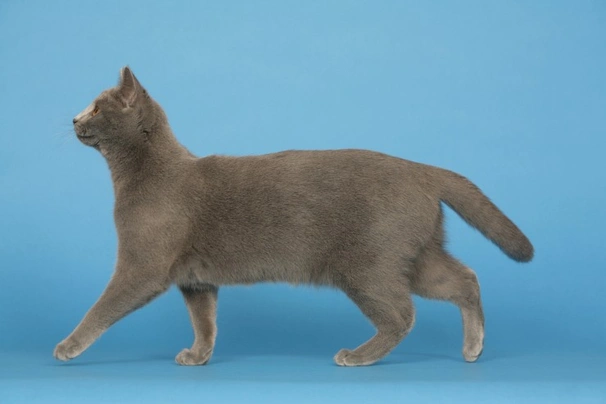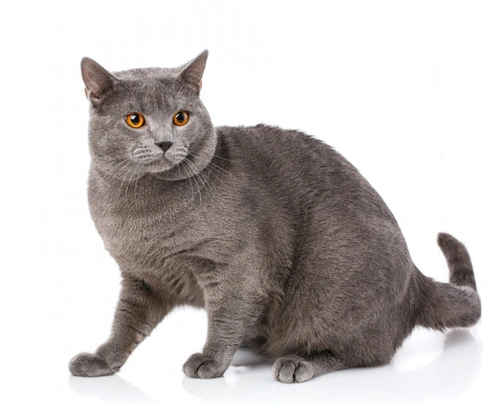Chartreux
Introduction of the Chartreux
The Chartreux is one of the oldest French breeds and boasts being among the very few true blue coated cats. For a long time these charming medium size cats have been popular companions and family pets thanks to their kind placid and gentle natures. They are known to form strong bonds with their families and over the years the Chartreux has earned the reputation of being tremendously good mousers.
History of the Chartreux
The actual origins of the Chartreux remain a bit of a mystery although there is a legend that tells of their ancestors having come from what is now called Syria and that these cats were introduced to France by Crusaders returning to France during the 13th century. Battle weary crusaders took refuge in Monasteries located in the French Alps to recover from the prolonged wars against the Turks. Here they lived a monastic life and started to breed the "blue cats" they had bought with them on their return to Europe. One of the monasteries was called Grande Chartreuse and as such the cats became known as the Chartreux.
However it was not until the 16th century that stories of the fascinating "Blue cats of France" started circulating in other parts of Europe. The cats were at one time hunted because their fur was so highly prized by furriers. Many colonies of Chartreux were often seen in Paris and other regions of the land right up until the beginning of the 20th century but their numbers were always quite low. It was not until after World War I that breeders started to show an interest in saving an ancient breed and as such they began carefully and selectively breeding from colonies that existed at the time. The first cats were exhibited in France in 1931.
A breed standard was eventually set which was based on early descriptions of the Chartreux written by 18th century naturalists. This same standard has not changed that much to the present day. During the 1700s a French biologist called the Comte de Buffon spoke about four distinct breeds which existed in France during that period of time this included the Chartreux the Angora the Domestic and the Spanish.
However as with many other breeds World War II had a serious impact on breed numbers which were seen to fall dangerously low but thanks to dedicated breeders the Chartreux was saved from extinction when existing cats were crossed with other breeds which included the British Shorthair Persians and Russian Blues. Today the Chartreux remains one of the most popular breeds and has been recognised by all the major international breed associations.
Appearance of the Chartreux
The Chartreux is a well built robust cat and they have quite short legs in relation to the rest of their bodies. One of their most striking characteristics is their short double extremely weather-resistant coat which consists of long guard hairs that cover a much woolier and shorter undercoat. Mature cats form "breaks" or it clumps in their coats especially around their necks legs and chests making them very similar in appearance to that of a sheep.
They do not reach full maturity until they are 2 years old but they always have a characteristic look about them more especially because of their constant "smile". Males are generally that much larger than their female counterparts and they mature a little later too. However both males and females boast having broad rounded heads with powerful jaws and nice full cheeks with males having more of a jowl than females.
They have nicely contoured foreheads and moderately long and wide straight noses with a slight stop which is found at a cat's eye level. Their ears have a nice width and height to them being set high which cats hold upright. Their eyes are rounded and open with cats always having a gentle yet alert expression in them. Their eye colour can be copper right through to gold but the preferred colour is a brilliant orange. They have relatively small and narrow muzzles and the Chartreux always boasts a lovely gentle smile which is one of their endearing physical traits.
Their necks are heavy set and short and a Chartreux has a robust moderately long body with deep chest and broad shoulders. Females are medium in size whereas males are larger but both have moderately long tails that are heavier at the base before tapering to an oval tip. Cats carry their tails in a lively fashion. They boast having relatively short fine-boned straight sturdy legs and medium size round shaped feet which often look quite dainty for such a cobby cat.
When it comes to their coat the Chartreux has a medium to short slightly woolly coat which breaks around their neck and flanks much like that of a sheep. They have very dense and weather resistant undercoats with a much longer topcoat. It's worth noting that the woolliness of a cat's coat depends on their age sex and living environment but in general males have heavier coats than their female counterparts. The only acceptable coat colour is a varying shade of grey which is as follows:
- Bright blue-grey from ash to slate grey with the tips of a cat's guard hairs being brushed with silver
Temperament of the Chartreux
The Chartreux has always been highly prized for their loyal and loving natures. They are independent yet boast having a kind and polite way about them which makes them all the more endearing to live with. Although they form strong bonds with their families they form a very strong tie with one person which is typically the person who takes the most care of them and will follow them about from room to room just to be close to them.
The Chartreux never objects to being left on their own even for longer periods of time but never like to be on their own for too long. They like to watch things that go on around them rather than get involved in short they like to think about things before making a decision or making a move. They are also known to be quiet cats by nature and that they "chirp" rather than meow when they want to get their owner’s attention.
Over the centuries the Chartreux has earned the reputation for being an excellent mouser and being natural hunters they love chasing anything that moves which includes toys. However as previously mentioned a Chartreux always thinks before they pounce making sure they do so at the right moment. With this said they like to play in short spurts in between lots of cat naps during the day. They are very much "creatures of habit" and don't particularly like any changes being made to their routine. They are also very sensitive by nature and don't like being told off but love it when they are praised.
Intelligence / Trainability of the Chartreux
The Chartreux is an intelligent cat but they like to take their time about things even when they are called by their name. They are the real "thinkers" of the cat world but once they make up their minds they are incredibly agile and fast on their feet which is one of the reasons they are known to be extremely good "natural hunters" and exceptionally good mousers.
Children and other
The Chartreux with their affectionate kind and placid personalities are the perfect choice for families with children and this includes toddlers. However small children need to be taught how to behave and handle cats to avoid any mishaps. With this said the Chartreux is known to be quite tolerant and will quickly get out of the way when children get too boisterous and noisy.
They also get on well with dogs as long as they are good around cats that is. However care has to be taken when introducing a Chartreux to a dog they don't already know just in case the dog does not get on with their feline counterparts. It's always wiser to keep a close eye on any cat which includes a Chartreux when they are around smaller pets just in case bearing in mind they are renowned for being natural hunters.
Health of the Chartreux
The average life expectancy of a Chartreux is between 12 and 15 years when properly cared for and fed an appropriate good quality diet to suit their ages. The breed is thought to be among the healthiest of the pure cat breeds. However there are a few conditions that have been reported in the breed worth knowing about and these include the following:
- Patellar luxation
- Polycystic kidney disease - Breeders should have stud cats tested
- Struvite stones in the urinary tract
Caring for the Chartreux
The Chartreux needs to be groomed on a regular basis to make sure their coats and skin are kept in top condition. On top of this cats need to be fed good quality food that meets all their nutritional needs throughout their lives which is especially important in kittens and older cats.
Grooming of the Chartreux
The Chartreux boast having a close lying coat that consists of long guard hairs over a much shorter and denser undercoat. As such they are low maintenance on the grooming front. A weekly brush is all it takes to keep their coats in good condition and to remove loose hair. They tend to shed quite heavily in the Spring and then again in the Autumn when more frequent brushing is usually necessary to keep on top of things.
It's also important to check a cat's ears on a regular basis and to clean them when necessary. If too much wax builds up it can lead to a painful infection which can be hard to clear up. In short prevention is often easier than cure with ear infections. Cats often suffer from ear mites which can be a real problem which is another reason why it's so important to check their ears on a regular basis.
Exercise of the Chartreux
The Chartreux is not a high energy cat but they do like to be kept busy. Playtime tends to be short bursts of energy in between lots of daytime naps taken in cosy corners. They are "natural hunters" and love nothing more than to anything that moves which as previously mentioned includes toys. They love to explore the great outdoors but only if it is safe for them to do so.
Cats kept as indoor pets need to be given lots of things to do as such it's a good idea to invest in scratching posts and interactive toys. They also need to have lots of places they can snuggle up for a snooze when the mood takes them because if there is one thing the Chartreux really enjoys it's napping during the day.
Feeding of the Chartreux
If you get a Chartreux kitten from a breeder they would give you a feeding schedule and it's important to stick to the same routine feeding the same kitten food to avoid any tummy upsets. You can change a kitten's diet but this needs to be done very gradually always making sure they don't develop any digestive upsets and if they do it's best to put them back on their original diet and to discuss things with the vet before attempting to change it again.
Older cats are not known to be fussy eaters but this does not mean they can be given a lower quality diet. It's best to feed a mature cat several times a day making sure it's good quality food that meets all their nutritional requirements which is especially important as cats get older. It's also essential to keep an eye on a cat's weight because if they start to put on too much it can have a serious impact on their overall health and wellbeing. Like all other breeds the Chartreux needs to have free access to fresh clean water at all times.
Chartreux price
If you get a Chartreux kitten from a breeder, they will provide a feeding schedule and it is important to follow the same routine, offering the same kitten food to avoid stomach issues. You can change a kitten's diet, but this must be done very gradually, always ensuring that it does not develop digestive problems; if it does, it is better to revert to the original diet and discuss it with the veterinarian before trying to change it again.
Older cats are not known to be finicky with food, but this does not mean they can be fed a lower quality diet. It is better to feed an adult cat multiple times a day, ensuring that the food is of good quality and meets all its nutritional requirements, which is particularly important as they age. It is also essential to monitor the cat's weight, as excessive weight gain can seriously impact its overall health and well-being. Like all other breeds, the Chartreux also needs to have access to fresh, clean water at all times.



